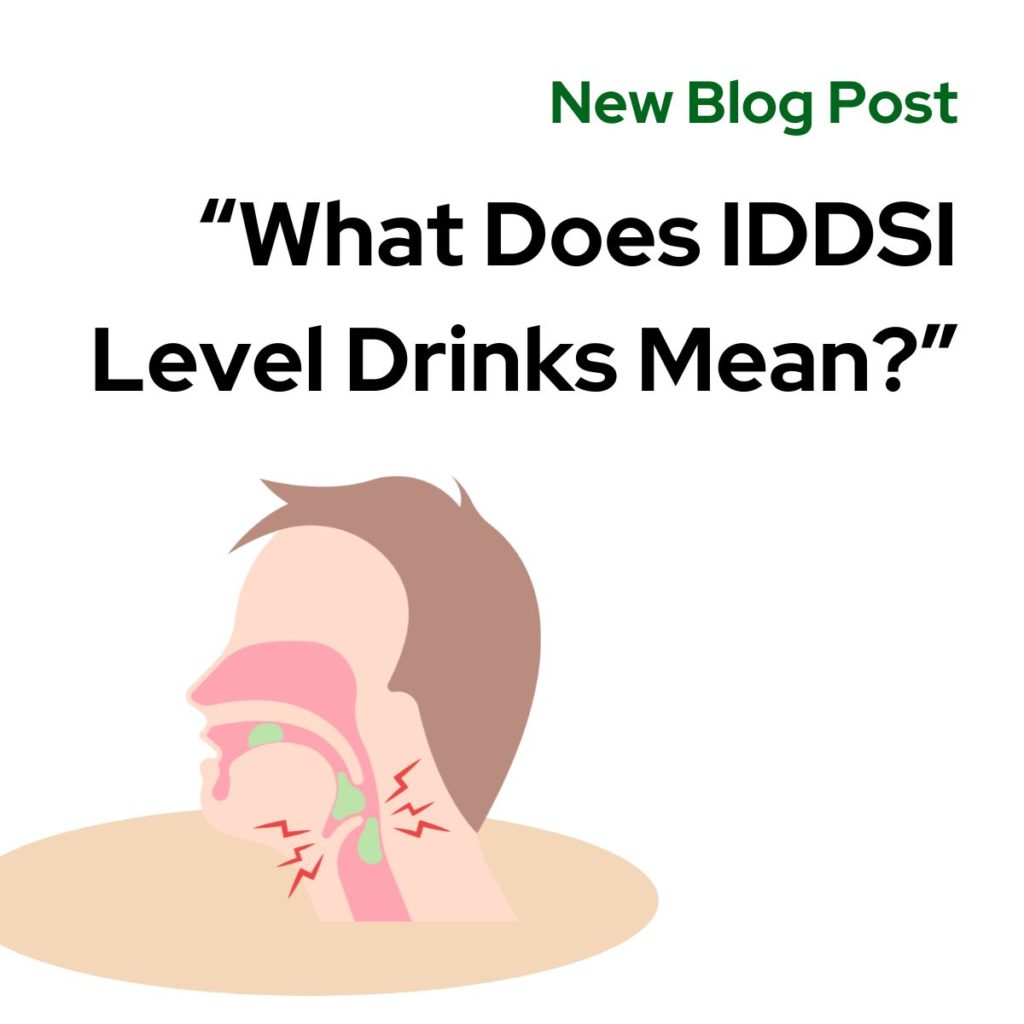
The International Dysphagia Diet Standardisation Initiative (IDDSI) has brought about a significant change in how foods and liquids are classified for individuals with dysphagia, a condition that affects the ability to swallow. IDDSI provides a framework that standardises the texture and consistency of foods and drinks to ensure they are safe for people with swallowing difficulties. In this blog post, we’ll focus on IDDSI Level drinks, exploring what they are, why they are important, and how they are used to support individuals with dysphagia.
1. Understanding Dysphagia
Dysphagia is a medical condition characterised by difficulty swallowing, which can occur due to a variety of underlying health issues, such as stroke, neurological disorders, or head and neck cancers. Individuals with dysphagia may be at risk of choking, aspiration (food or liquid entering the airway), and malnutrition, making it crucial to modify the texture of their foods and drinks to prevent these complications.
- Types of Dysphagia: There are two main types of dysphagia: oropharyngeal dysphagia, which involves difficulty in the mouth and throat, and oesophageal dysphagia, which involves difficulty in the oesophagus. Both types can affect the ability to swallow liquids safely.
- Symptoms: Common symptoms of dysphagia include coughing or choking while eating or drinking, a sensation of food sticking in the throat, and recurrent pneumonia caused by aspiration. Managing dysphagia often involves modifying the consistency of foods and drinks to make them easier and safer to swallow.
2. The Role of IDDSI
The IDDSI framework was developed to provide a universal standard for classifying the texture and consistency of foods and liquids for individuals with dysphagia. The framework is designed to be used across different healthcare settings and by professionals, caregivers, and individuals managing dysphagia.
- Global Standardisation: IDDSI is used internationally, ensuring that there is a consistent approach to managing dysphagia regardless of location. This standardisation is important for improving safety and care quality for individuals with swallowing difficulties.
- The IDDSI Framework: The IDDSI framework consists of eight levels, ranging from Level 0 (thin liquids) to Level 7 (regular foods). The levels are colour-coded and numbered to make them easy to understand and apply. Levels 0-4 are specifically focused on liquids, while Levels 3-7 pertain to food textures.
3. IDDSI Level Drinks: An Overview
IDDSI Level drinks are classified into five levels based on their thickness and flow properties. These levels help healthcare providers and caregivers determine the appropriate consistency of liquids for individuals with dysphagia.
- Level 0: Thin Liquids
- Description: Thin liquids have a consistency similar to water and flow quickly through a straw or spoon. They do not require any modification and are typically not recommended for individuals with severe dysphagia, as they pose a high risk of aspiration.
- Examples: Water, tea, coffee, and other clear beverages.
- Level 1: Slightly Thick
- Description: Slightly thick liquids have a consistency slightly thicker than water. They flow easily but at a slightly slower rate than thin liquids. These liquids are often used for individuals with mild dysphagia.
- Examples: Nectar, fruit juices with pulp, and some smoothies.
- Level 2: Mildly Thick
- Description: Mildly thick liquids have a texture similar to cream soup or thickened juice. They flow slowly off a spoon and can be sipped from a cup but may require more effort to drink through a straw.
- Examples: Thickened fruit juices, thicker smoothies, and some milkshakes.
- Level 3: Moderately Thick
- Description: Moderately thick liquids are even thicker and have a consistency similar to honey. They can be spooned but may not flow easily through a straw. These liquids are used for individuals who require significant modifications to reduce the risk of aspiration.
- Examples: Honey-thick liquids, thickened soups, and thick milkshakes.
- Level 4: Extremely Thick
- Description: Extremely thick liquids, also known as “pureed” or “pudding-thick” liquids, do not flow and need to be eaten with a spoon. They are used for individuals with severe dysphagia who are at high risk of choking or aspiration.
- Examples: Pureed fruits, yoghurt, and thickened puddings.
4. Why IDDSI Level Drinks are Important
IDDSI Level drinks are crucial for ensuring the safety and well-being of individuals with dysphagia. By standardising the consistency of liquids, the IDDSI framework helps reduce the risk of choking and aspiration, which can lead to serious health complications.
- Safety: Modifying the consistency of liquids helps prevent them from entering the airway, reducing the risk of aspiration pneumonia, a potentially life-threatening condition that occurs when food or liquid is inhaled into the lungs.
- Nutritional Support: Ensuring that individuals with dysphagia can safely consume liquids is essential for maintaining hydration and nutrition. Dehydration and malnutrition are common concerns for individuals with swallowing difficulties, and appropriate IDDSI Level drinks can help address these issues.
- Quality of Life: Being able to safely consume liquids that are appropriate for one’s level of dysphagia can improve an individual’s quality of life. It allows them to enjoy a variety of beverages and maintain social interactions, such as sharing a drink with friends or family, without the fear of choking.
5. How IDDSI Level Drinks are Prepared
Preparing IDDSI Level drinks involves modifying the thickness of liquids to meet the specific requirements of each level. This can be done using commercial thickening agents or by preparing naturally thickened liquids.
- Thickening Agents: Commercial thickening agents, such as powdered thickeners, are commonly used to achieve the desired consistency for IDDSI Level drinks. These agents are added to liquids and stirred until the appropriate thickness is reached. It’s important to follow the manufacturer’s instructions to ensure the correct consistency is achieved.
- Naturally Thickened Liquids: Some liquids are naturally thick and may not require additional thickening agents. For example, smoothies, pureed soups, and yoghurt may already meet the requirements for certain IDDSI levels. However, it’s still important to test these liquids to ensure they meet the appropriate consistency standards.
- Testing Consistency: To ensure that liquids are at the correct IDDSI level, healthcare providers and caregivers often use flow tests or spoon tests. These tests involve measuring the time it takes for a liquid to flow through a syringe or observing how the liquid behaves on a spoon.
6. Challenges in Implementing IDDSI Level Drinks
While the IDDSI framework provides a clear standard for managing dysphagia, there are challenges associated with implementing IDDSI Level drinks.
- Consistency in Preparation: Ensuring that liquids are consistently prepared to the correct IDDSI level can be challenging, particularly in settings where multiple caregivers are involved in meal preparation. Variations in preparation methods can lead to inconsistencies in the thickness of liquids, which can impact safety.
- Taste and Palatability: Some individuals with dysphagia may find that thickened liquids have an altered taste or texture, which can affect their willingness to consume them. This can be particularly challenging for individuals who are already at risk of malnutrition or dehydration.
- Training and Education: Proper training and education are essential for healthcare providers, caregivers, and individuals with dysphagia to ensure that IDDSI Level drinks are prepared and consumed safely. This includes understanding the different IDDSI levels, knowing how to use thickening agents, and recognising the importance of consistency in preparation.
7. The Role of Healthcare Providers
Healthcare providers play a critical role in implementing the IDDSI framework and ensuring that individuals with dysphagia receive the appropriate IDDSI Level drinks.
- Assessment: Healthcare providers, such as speech and language therapists, are responsible for assessing an individual’s swallowing ability and determining the appropriate IDDSI level for their drinks. This assessment is based on a thorough evaluation of the individual’s swallowing function and any associated risks.
- Education and Training: Healthcare providers also provide education and training to caregivers and individuals with dysphagia on how to prepare and consume IDDSI Level drinks safely. This includes demonstrating how to use thickening agents, conducting flow tests, and explaining the importance of adhering to the recommended IDDSI level.
- Ongoing Support: Dysphagia is often a dynamic condition, and an individual’s needs may change over time. Healthcare providers play a key role in monitoring the individual’s progress, reassessing their swallowing function, and adjusting the IDDSI level of their drinks as needed.
IDDSI Level drinks are an essential component of managing dysphagia, providing a standardised approach to ensuring the safety and well-being of individuals with swallowing difficulties. By modifying the thickness of liquids to meet the specific needs of each individual, the IDDSI framework helps reduce the risk of choking and aspiration, supports hydration and nutrition, and improves the quality of life for those with dysphagia.
Implementing IDDSI Level drinks requires careful attention to detail, consistency in preparation, and ongoing support from healthcare providers. While there are challenges associated with preparing and consuming thickened liquids, the benefits of adhering to the IDDSI framework far outweigh these challenges, making it a valuable tool in the management of dysphagia.
As awareness of dysphagia continues to grow and the IDDSI framework becomes more widely adopted, it is hoped that more individuals with swallowing difficulties will have access to the safe, appropriate, and enjoyable beverages they need to maintain their health and well-being.

